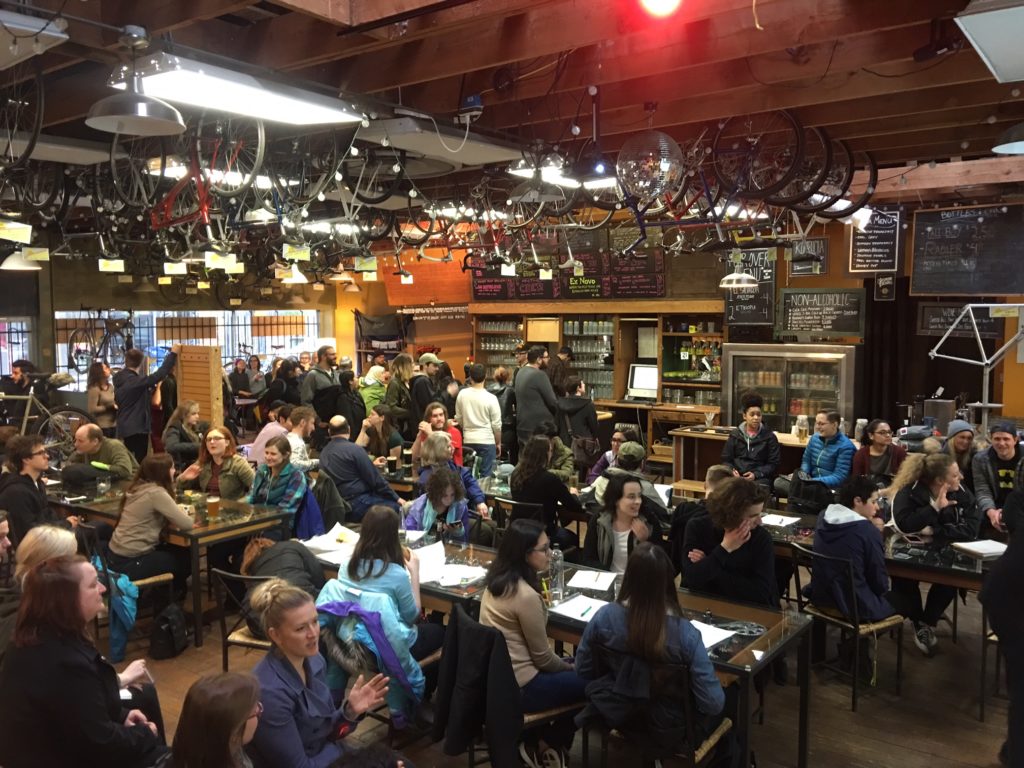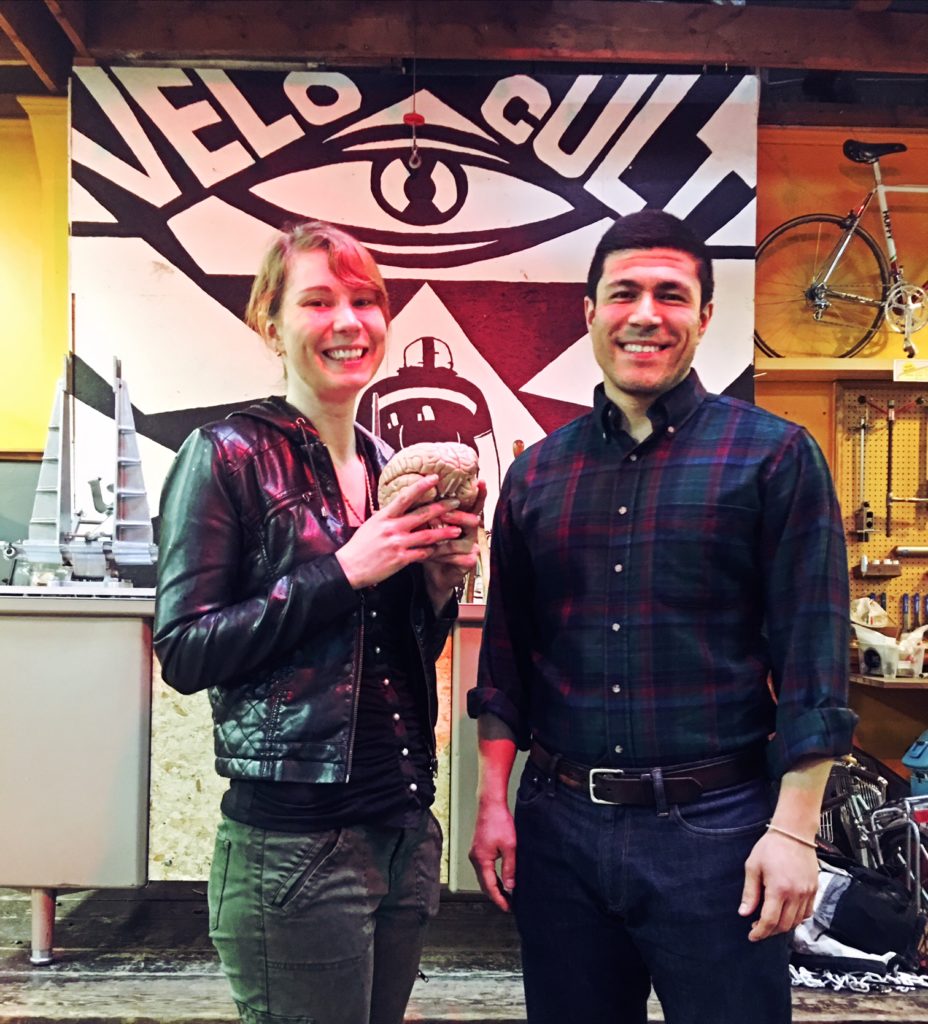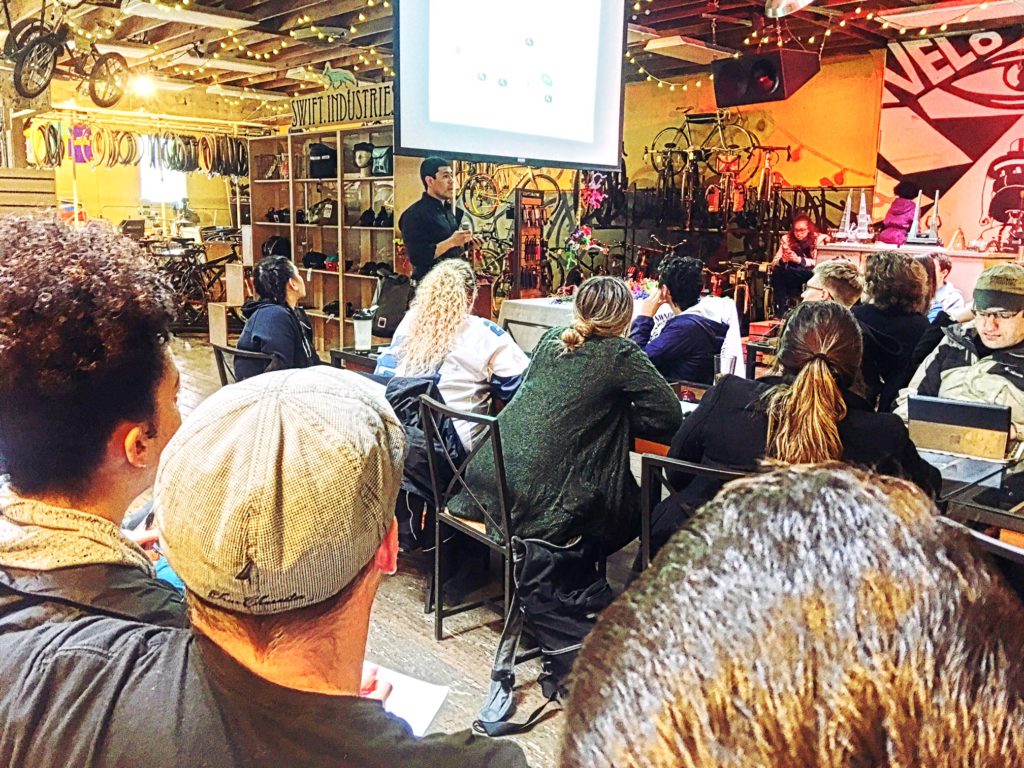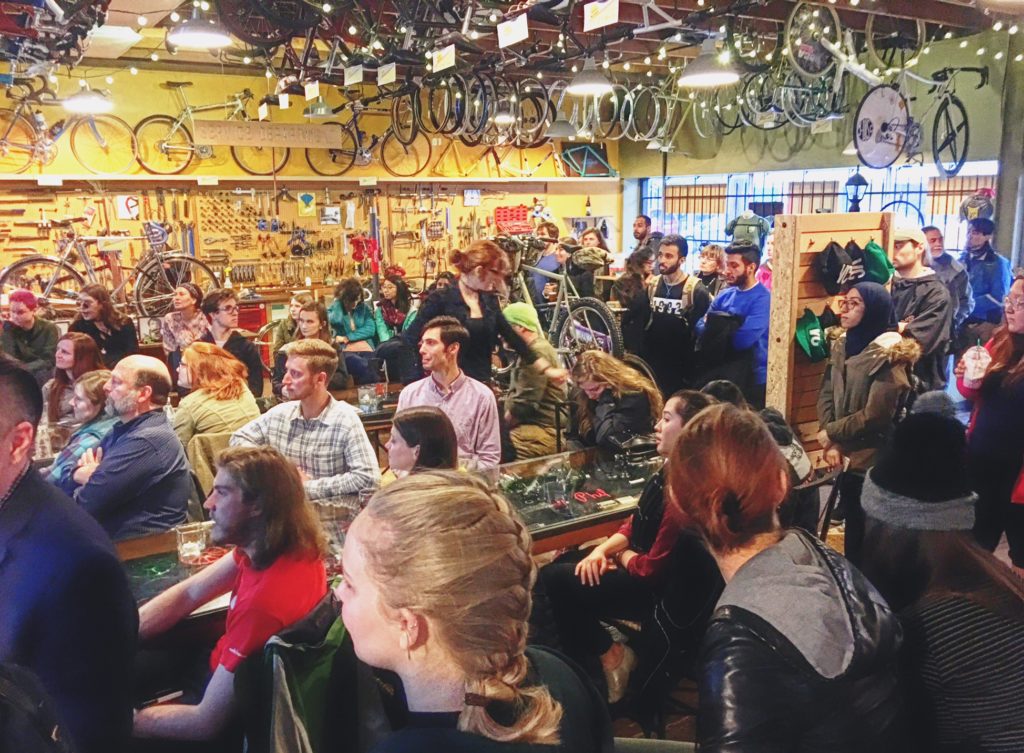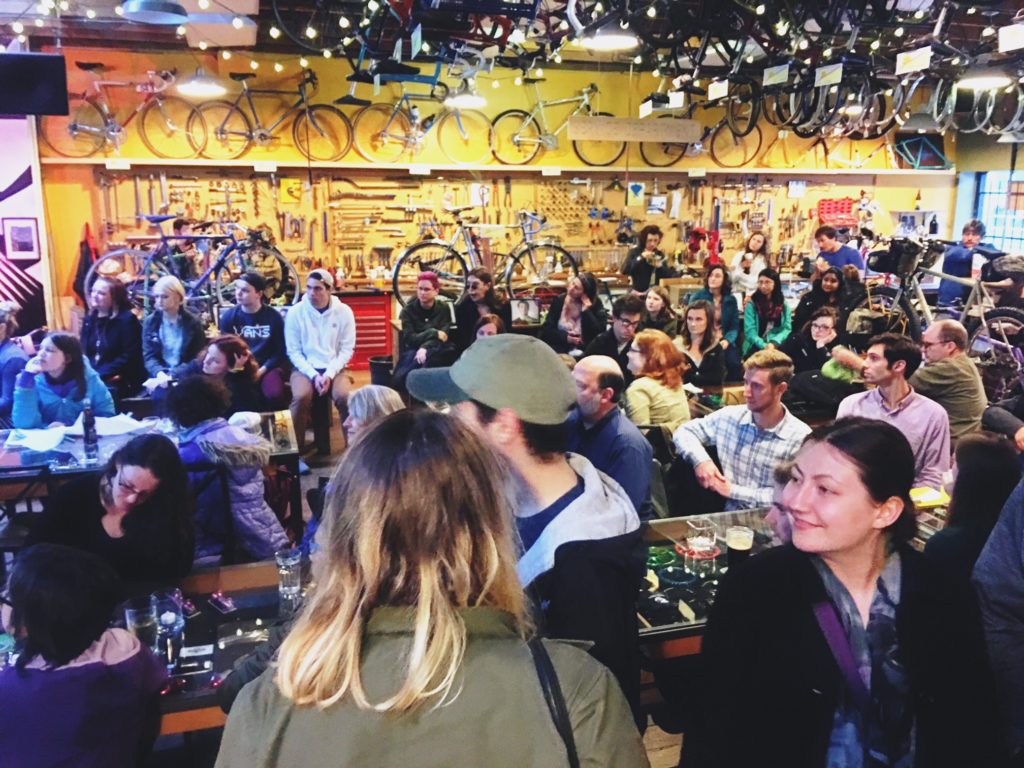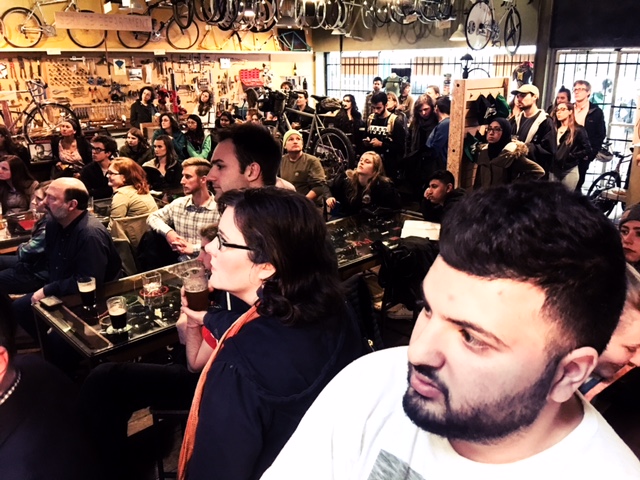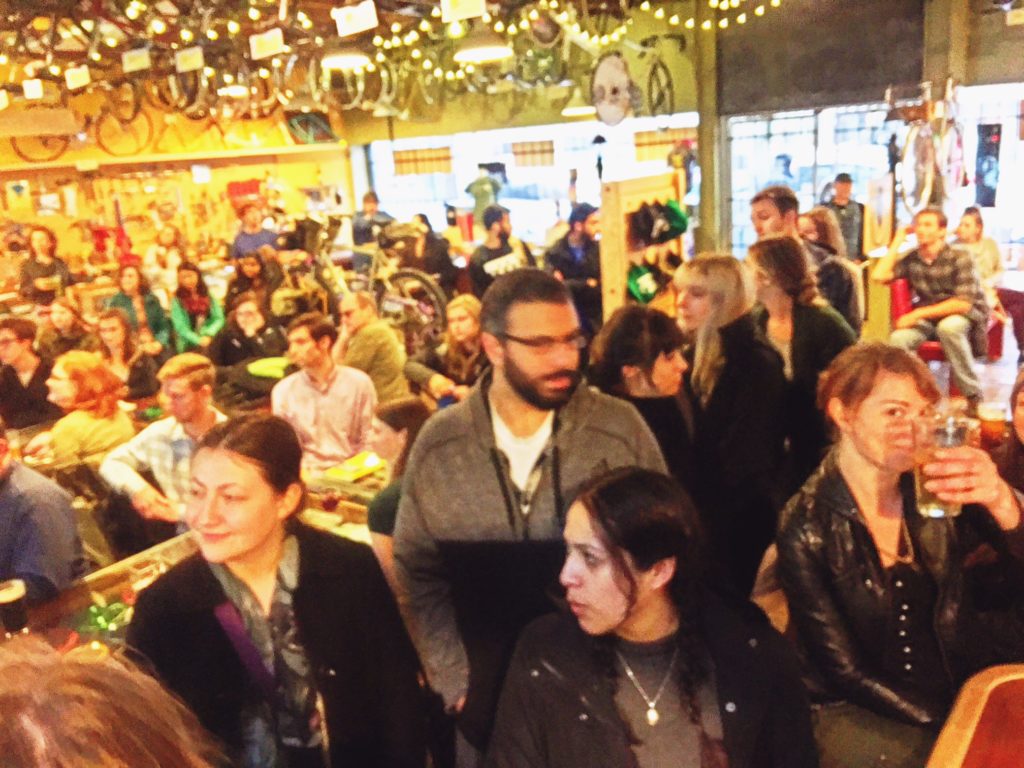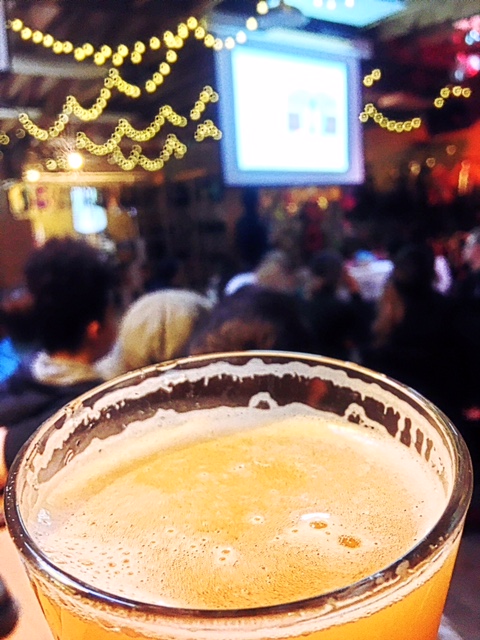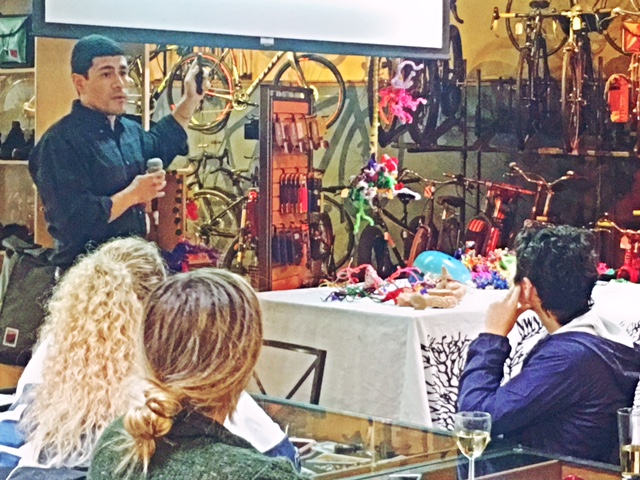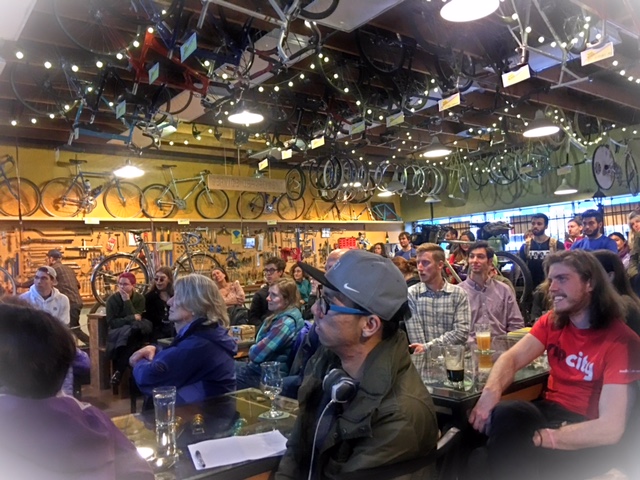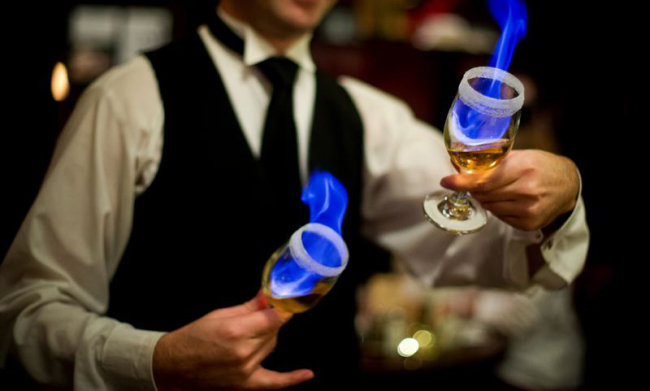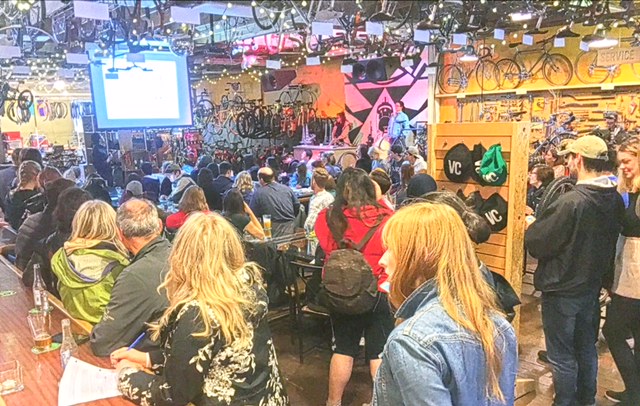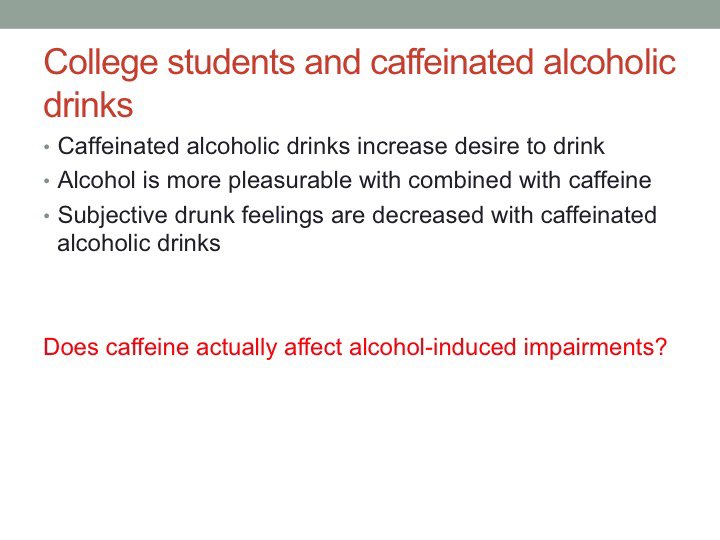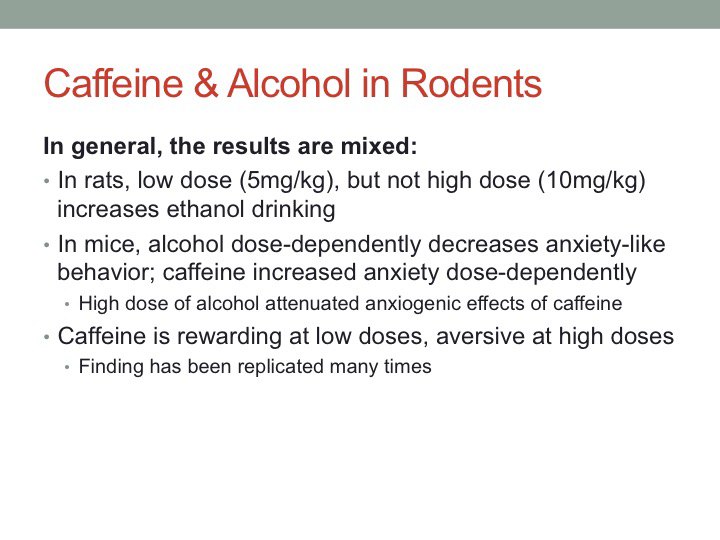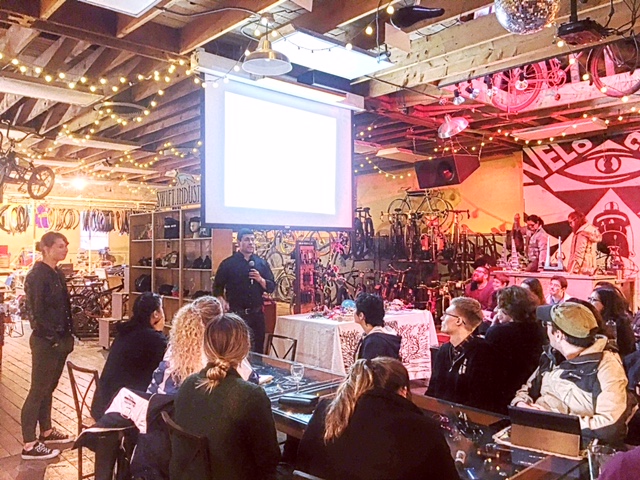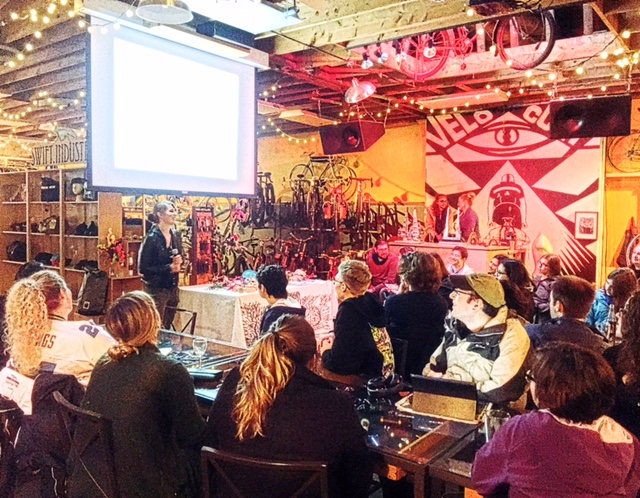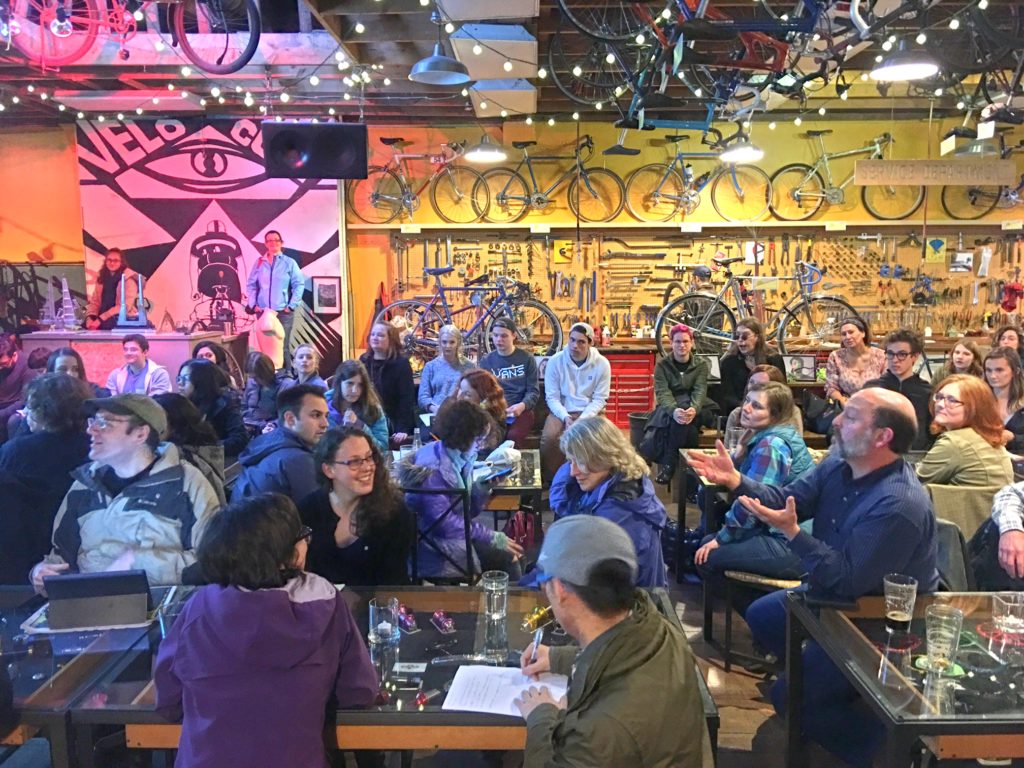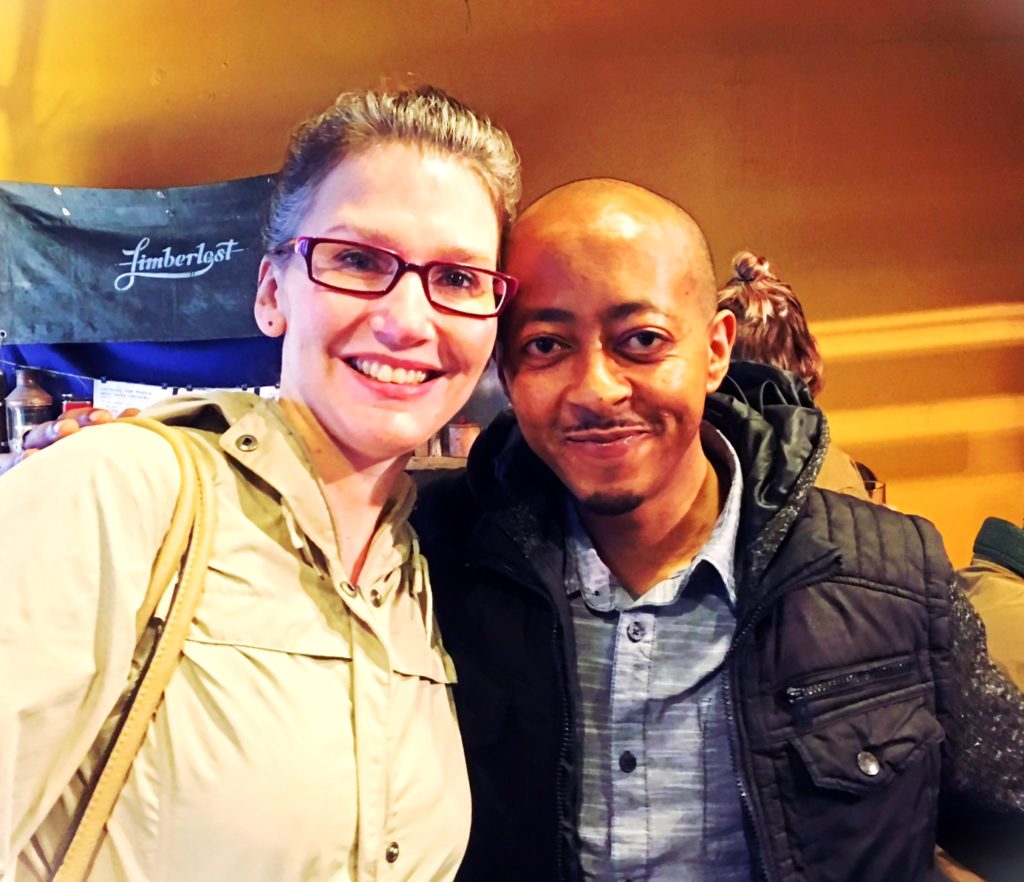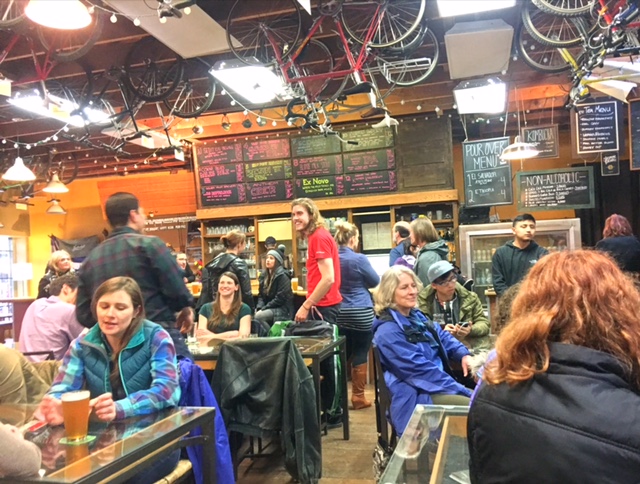Alcohol and caffeine – and science and art – are clearly dear to Northwest hearts (and dopamine networks), so an unusually large crowd gathered amidst the bikes and beverages at Velo Cult this week to learn about what combining these drugs might do to our brains…
We were there to learn about research from Alfredo Zuñiga, a graduate student in Behavioral Neuroscience at OHSU, on the interaction of psychoactive ingredients in some terrific brews – both pour-over and pint-poured – available at our favorite bicycle repair shop, coffee spot and bar…
The crowds also came to hear Kimberly Engeln, an undergraduate in Neuroscience at WSU Vancouver, who conducts research in Suzy Renn’s Biology lab at Reed College. Kim presented her own compelling photographs of people after they had consumed caffeine, alcohol – or both!
Which was which?
Alfredo began by explaining that his presentation, which would cover the behavioral consequences of ingesting both drinks, may have been partially funded by La Croix… 🙂
According to the National Institute of Alcohol Abuse and Alcoholism, moderate social drinking offers health benefits for adults; however, excessive drinking kills 88,000 Americans annually, and exacts an estimated $249 billion dollar economic cost…
LEARN MORE: Alcohol & Your Health
LEARN MORE: What’s a “drink..?” At the Newmark for beer & brains
Though people often mix their liquor with caffeine. Examples include the Spanish coffee at Huber’s, an Irish coffee at Kell’s, that Red Bull and vodka at Splash Bar, or the original Four Loko from a Plaid Pantry. Does this combination impact our drinking behavior in measurable ways? Where does caffeine act in the brain, and how might that account for any observed changes?
LEARN MORE: English Abbey’s Caffeinated Wine Gains Popularity and Scrutiny
Caffeine, explained Alfredo, is popular – in fact, it is the most popular drug in the world. And according to a 2011 survey by coffee purveyor Dunkin Donuts, scientists and lab technicians regularly top the list of those professions with the highest proportion of workers “who need coffee to get through the day..!”
LEARN MORE: SURVEY REVEALS WHICH PROFESSIONS NEED COFFEE THE MOST
LEARN MORE: Caffeine (from Medline Plus)
LEARN MORE: Coffee: The demon drink?
Caffeine is produced naturally by plants, including coffee, tea, yerba mate and guarana. It is toxic to some insects, and it can contaminate surrounding soil, making it hard for competitive plants to grow. It also offers an arousing, memory enhancing buzz to bees, increasing pollination!
LEARN MORE: Caffeinated forage tricks honeybees into increasing foraging and recruitment
Caffeine is consumed orally (through the mouth), typically in a beverage like coffee, or tea…
It is metabolized (broken down) by enzymes in the liver, and has a half life of about 3 – 7 hours…
Apparently a coffee enema (“CE” from the figure above) is less effective at making caffeine “bioavailable” to its receptor targets in your nervous system than oral coffee consumption (CC) – but the half life remains the same. So an Americano is not only tastier, but better at delivering the goods!
So once bioavailable, and swirling around your brain for hours after that cup (or enema), where does this popular chemical act? Which specific protein receptors does it target, and how does it alter their structure and impact their usual activity, leading to a more alert and functional state..?
Caffeine acts at receptors for adenosine, a chemical “neuromodulator” that reduces release of several critical neurotransmitters, including dopamine, norepinephrine, serotonin and acetylcholine that are essential for arousal and alertness. Adenosine is a nucleotide (found in DNA, mRNA), and part of an important energy substrate known as ATP, or adenosine tri-phosphate…
As your day progresses, and you express genes and use ATP, your bloodstream levels of adenosine rise, and bind to adenosine receptors in several cerebral regions, including an area beneath frontal cortex called the basal forebrain. This decreases neuronal activity and you feel sleepy, and cognitively slow – appropriately ready, of course, for a restorative sleep, or nap…
But then you enjoy that glorious and rewarding cup of joe, and the caffeine finds your adenosine receptors, displacing that downer adenosine and binding itself to your receptors instead. Caffeine blocks the normal response of this receptor, so it is an adenosine receptor antagonist…
There remain copious swarms of adenosine molecules circulating in your blood, and your body still needs rest, but your brain is no longer listening to this chemical signal with caffeine antagonizing the receptors in the basal forebrain and elsewhere where adenosine would normally act…
LEARN MORE: Caffeine and adenosine
Many audience members had heard of dopamine (DA), a neurotransmitter released in the brain in response to stimuli that predict the delivery of some reward. Dopamine release provokes motivating, anticipatory behavior, that we (and rats) tend to enjoy. Dopamine acts at its own DA receptors, but remarkably these DA receptors can form larger structural associations with receptors for other chemicals, including adenosine…
When receptors for two entirely different chemicals link together into a larger structure, it’s called a heteromer, and DA/adenosine heteromeric receptor complexes have been identified in dopamine pathways associated with reward. As your adenosine levels rise, adenosine binds to these heteromeric receptors, decreasing their response to dopamine…
So as you get fatigued, it’s harder to get motivated to continue…
LEARN MORE: Heteromeric Dopamine Receptor Signaling Complexes: Emerging Neurobiology and Disease Relevance
LEARN MORE: An Update on Adenosine A2A-Dopamine D2 receptor interactions
But caffeine, of course, blocks adenosine’s action – it prevents it from binding to its receptor – and may therefore help maintain more dopamine response. It can keep you awake, and going, and motivated to respond further…
Alcohol is both motivating – and, it turns, out, increases adenosine. So that delicious IPA at Velo will raise adenosine levels in your brain, and as you keep drinking, you’ll get sleepy.
Alcohol is somnogenic, or sleep generating, and ultimately leads to ataxia (that is, it makes you uncoordinated in your movements)…
LEARN MORE: Acute effects of alcohol on the human brain: a resting-state FMRI study
This increased adenosine is probably beneficial, helping you slow your drinking and get some needed sleep. As Alfredo described it, adenosine may be acting as a helpful “brake…”
But then you add the Red Bull, or the after dinner espresso, and all of a sudden it’s brakes off!
Caffeinated alcoholic beverages have certainly been popular for a long, long time – Hubers, for example, has served their signature Spanish coffee in downtown Portland for more than a century..!
However, few diners at Hubers pound multiple Spanish coffees. In contrast, caffeinated alcoholic beverages like the short-lived Four Loko reportedly led to “mass hospitalizations,” and caffeine was ultimately removed from these drinks under orders from the Food and Drug Administration…
LEARN MORE: FDA on Caffeinated Alcoholic Beverages
LEARN MORE: Alcohol and Caffeine: The Perfect Storm
LEARN MORE: The Four-Loko Effect
College students, like many in attendance, are huge consumers of both alcohol and caffeine…
And Alfredo has found that rats given low doses of caffeine (though not high doses) increase their consumption of alcohol. In mice, researchers have found that caffeine by itself is rewarding at low doses (mice will choose to linger in area where caffeine was previously delivered, for example) – but at high doses, as with humans, it’s not something they find motivating…
Kim Engeln then took the stage to describe her photographs!
From Kim…
“When I was asked to create an artistic piece to complement Alfredo’s research, I knew I wanted to use my favorite medium: photography. I thought of Charles Darwin and his book “On the Expression of Emotions in Man and Animals” and wanted to capture the humorous and truthful aspects of facial expressions seen in his own photography experiments…
LEARN MORE: On the Expression of Emotions in Man and Animals
It was really easy finding volunteers for this project – all it took was an invitation to brunch served with free coffee and alcohol!
At Velo Cult, I encouraged the audience to try to guess which portraits were taken right after drinking a pot of coffee, which photos were of us mixing coffee and alcohol, and which photos showed us with only booze left in our system. The drunken photos were easy enough for everyone to guess – our droopy eyes, messy hair, and wild expressions (especially Allie’s!) gave it away.
However there was quite a bit of disagreement over the coffee only photos, and the coffee and alcohol photos. Some thought the big smiles on our faces were from the caffeine, while others thought the alcohol was the contributor.
Personally, I think it was the eyes that gave it away as I noticed how our eyelids tended to droop more and more as the ethanol in our bloodstreams rose, and the caffeine faded.
I had a lot of fun with this project and I wanted the viewers of my photographs to get a sense of the fun and laughter my friends and I shared during our brunch. I got a chance to meet all sorts of members of our community – scientists, students, and curious Portlanders alike, and I think everyone had a great time exchanging laughs and conversing about art and science over pints of beer!”
Afterwards we had fun milling about, discussing research, asking questions, making connections…
Many thanks to Alfredo, Kim and the incomparable Velo Cult for another great public evening of neuroscience & art!



